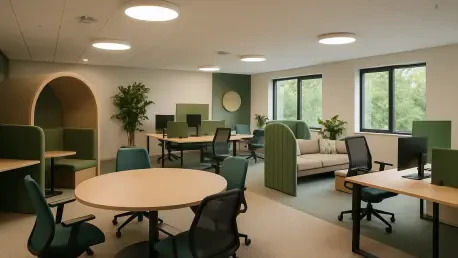In an era where the traditional concept of the office is being rapidly reshaped, Cisco stands at the forefront of a movement to create human-centered workplaces that resonate with the diverse needs of today’s employees, going beyond mere aesthetics or functionality. The company’s groundbreaking approach dives deep into the essence of what a workplace should represent—a dynamic environment that fosters collaboration, personal growth, and genuine inclusion. A shining example of this philosophy is evident in the recent renovation of their Finsbury Circus office in Central London, where innovative design principles, particularly neuroinclusion, are brought to life. This transformative vision reimagines office spaces as hubs that not only accommodate but celebrate the unique ways individuals think, process information, and interact with their surroundings. By prioritizing adaptability and employee well-being, Cisco is setting a new standard for what modern workplaces can achieve, paving the way for a future where every worker feels valued and supported.
Evolving Purpose of the Modern Office
The role of the office has undergone a profound transformation in recent years, shifting from a static place of routine tasks to a vibrant destination for meaningful engagement. Cisco recognizes that today’s employees seek environments that facilitate in-person collaboration, mentorship opportunities, and a deep sense of cultural connection within their organizations. No longer just a backdrop for work, offices must adapt to the fluid nature of daily activities, offering spaces for focused efforts, confidential discussions, and even quiet moments of respite. When workplaces fail to provide such versatility, their relevance wanes, prompting employees to explore alternative methods of connecting with colleagues. Cisco’s response to this challenge is a design ethos centered on inclusion, ensuring that office spaces are tailored to accommodate a spectrum of work styles and personal preferences, thereby enhancing their value as indispensable hubs of productivity and interaction.
This shift in perspective underscores a broader industry realization that the workplace must mirror the dynamic lives of its occupants. Employees juggle varied responsibilities and require environments that seamlessly support transitions between collaborative brainstorming sessions and solitary deep thinking. Cisco’s approach tackles this by embedding flexibility into the very fabric of their office designs, ensuring that spaces can pivot to meet immediate needs without sacrificing comfort or efficiency. The emphasis on creating multi-functional areas reflects an understanding that a one-size-fits-all model no longer suffices in meeting the expectations of a modern workforce. By redefining the purpose of the office as a place of connection rather than obligation, Cisco is not only addressing current demands but also anticipating future shifts in how work is perceived and conducted, laying a foundation for sustained relevance and employee satisfaction.
Neuroinclusion as a Design Cornerstone
At the core of Cisco’s innovative workplace strategy lies the concept of neuroinclusion, a progressive framework that acknowledges and supports the diverse ways individuals perceive and process their environments. Unlike traditional accessibility measures that focus primarily on physical accommodations, neuroinclusion extends into the realm of cognitive and sensory experiences, ensuring that workplaces cater to a wide array of mental and emotional needs. This approach is a direct response to the growing diversity within the workforce, where employees bring unique perspectives and processing styles to the table. By designing spaces that are mentally supportive, Cisco aims to create environments where everyone, regardless of how they interact with the world, can perform at their best without unnecessary barriers or discomfort.
Implementing neuroinclusion involves a meticulous consideration of elements that influence sensory and cognitive well-being, such as noise levels, visual stimuli, and spatial configurations. Cisco’s commitment to this principle is evident in their efforts to minimize overstimulation while providing options for employees to engage with their surroundings in ways that feel most comfortable to them. This might mean offering quiet zones for those sensitive to sound or ensuring clear navigation paths to reduce anxiety for others. Such thoughtful design choices reflect a deeper understanding of the nuanced challenges faced by a varied workforce, positioning Cisco as a leader in fostering truly inclusive environments. By prioritizing these aspects, the company not only enhances individual productivity but also cultivates a culture of empathy and respect, where differences are not just accommodated but valued as strengths.
Showcasing Innovation at Finsbury Circus
The renovation of Cisco’s Finsbury Circus office in Central London serves as a powerful testament to the company’s forward-thinking vision for workplace design. This project emerged from internal research that identified critical gaps in conventional office layouts, particularly in their ability to support diverse cognitive needs and provide adequate spaces for recharge. By addressing these shortcomings head-on, Cisco transformed the space into a model of human-centered design, where technology and thoughtful planning converge to elevate the employee experience. The renovated office stands as a benchmark, illustrating how intentional design can create environments where every individual, regardless of their work style or sensory preferences, can thrive in harmony with their surroundings.
Beyond aesthetics, the Finsbury Circus project embodies a strategic blend of innovation and practicality, aiming to redefine what employees expect from their workplaces. The design process prioritized bridging the disconnect between traditional office setups and the evolving demands of a modern workforce, ensuring that spaces are not only functional but also deeply supportive. This involved rethinking how areas are zoned to cater to different activities, from high-energy collaboration to quiet introspection, thereby fostering an atmosphere of balance. The success of this renovation highlights Cisco’s ability to translate abstract concepts like inclusion into tangible, impactful outcomes, setting a precedent for other organizations to follow. As a flagship initiative, Finsbury Circus demonstrates the potential for workplaces to become catalysts for personal and professional growth, inspiring a reimagining of office spaces worldwide.
Crafting Neuroinclusive Environments
Cisco’s dedication to neuroinclusive design is vividly illustrated through specific elements integrated into the Finsbury Circus office, guided by their comprehensive Workplace Design Playbook. This framework addresses critical aspects such as spatial planning, sensory zoning, lighting adjustments, air quality control, acoustic management, and seamless technology integration. Open sight lines are strategically implemented to ease navigation and reduce feelings of anxiety, while the office is segmented into high- and low-stimulation zones, empowering employees to select environments that align with their sensory needs. Additionally, dedicated quiet spaces, like single-person reflection rooms, provide essential retreats for those needing a break from sensory overload, emphasizing a commitment to mental health and well-being in the workplace.
Attention to detail extends to every facet of the environment, ensuring that sensory sensitivities are meticulously managed to enhance comfort and focus. Lighting is designed for consistency yet offers flexibility with dimmable options and low-hanging fixtures in calmer areas to create soothing atmospheres. Air quality is optimized through sensor technology, promoting natural ventilation and reducing distracting odors, while acoustic treatments in focus zones and soundproof meeting rooms minimize noise disruptions. The choice of materials, such as calming neutral palettes and natural textures like wood, further prevents overstimulation, while subtle color accents aid in zoning clarity. These elements collectively create a workspace that not only supports diverse ways of working but also prioritizes the holistic health of employees, demonstrating how thoughtful design can profoundly impact daily experiences and long-term satisfaction.
Leveraging Technology for Inclusive Workspaces
Technology serves as a pivotal enabler in Cisco’s mission to build inclusive and adaptable workplaces, ensuring that both physical and digital environments meet the needs of all employees. Solutions like Cisco Spaces provide intuitive digital wayfinding, allowing individuals to easily locate available meeting rooms or workstations, thereby reducing stress and enhancing efficiency. Smart sensors integrated with building management systems continuously monitor and adjust environmental conditions based on real-time occupancy data, maintaining optimal settings for comfort across varied zones. This seamless use of technology underscores a commitment to creating spaces that are responsive to the immediate needs of their occupants, fostering a sense of control and accessibility.
Moreover, Cisco’s focus on hybrid work models is exemplified through tools like Webex, which ensure equitable meeting experiences for both in-office and remote participants. This integration bridges geographical divides, allowing for inclusive collaboration regardless of location, and reflects a nuanced understanding of the modern workforce’s distributed nature. By leveraging their expertise in tech solutions, Cisco transforms workplaces into smart ecosystems that adapt dynamically, prioritizing not just efficiency but also fairness in access to resources. Such advancements highlight technology’s role as more than a convenience—it becomes a cornerstone of inclusive design, enabling environments where every employee can engage fully, whether they are physically present or connecting from afar. This approach sets a powerful example of how innovation can drive equity and connectivity in workplace design.
Pioneering Human-Centered Workplace Trends
Cisco’s emphasis on neuroinclusion places the company at the vanguard of a significant trend toward human-centered workplace design, reflecting a broader industry shift toward environments that prioritize employee well-being and diversity. This perspective recognizes that offices must transcend mere functionality to become vibrant ecosystems where technology and human experience intersect to enhance productivity and creativity. By addressing the multifaceted needs of employees through thoughtful design and advanced solutions, Cisco is shaping spaces that balance the demands of collaborative work with the necessity for individual focus, ensuring that health and satisfaction remain at the forefront of workplace priorities.
This leadership in design innovation aligns with a growing consensus that modern workplaces must adapt to support varied lifestyles and work patterns, a challenge Cisco meets with a blend of empathy and technological prowess. Their approach not only responds to current expectations but also anticipates future needs, positioning the company as a trailblazer in redefining the office as a space of empowerment. The integration of neuroinclusive principles and smart technology serves as a model for others, illustrating how environments can be crafted to nurture both personal well-being and organizational success. As Cisco continues to apply these insights globally, their influence on workplace trends promises to inspire a wave of transformation, encouraging a rethinking of how spaces can serve as catalysts for human potential and collective achievement.
Reflecting on a Vision Realized
Looking back, Cisco’s journey to redefine workplace environments through the lens of neuroinclusive design marked a significant milestone in the evolution of office spaces. The transformation of the Finsbury Circus office in London stood as a concrete example of how intentional design, paired with cutting-edge technology, could create environments that supported diverse cognitive and sensory needs. Their efforts highlighted a pivotal shift in recognizing offices as more than places of work, but as ecosystems that nurtured collaboration, individual focus, and emotional well-being. Moving forward, the challenge lies in scaling these principles across varied cultural and regional contexts, ensuring that the benefits of such innovative design reach global workforces. As Cisco paved the way, the invitation remained open for other organizations to adopt similar strategies, prioritizing adaptability and inclusion to build workplaces that truly empowered every employee for the challenges and opportunities ahead.









